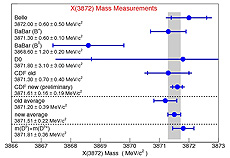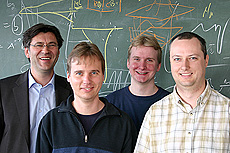Who is Mister X?

Comparison of the CDF new mass measurement using world's largest sample of X(3872) signal events to previous measurements and sum of the D0 and D0* masses.
Quarks are one of the elementary building blocks of matter. They are strange objects in the sense that scientists never observe them as individual free particles, but always in the form of hadrons, bound states of either three quarks, which create a baryon, or one quark and one anti-quark, which create a meson. The well-understood theory describing the interaction of quarks does not explicitly rule out exotic combinations of more than three quarks, but most physicists do not expect them to exist.
Scientists observed the first out of a series of hadrons that are candidates for such exotic states, the X(3872), in 2003. Physicists still do not know the internal structure of the X(3872). The two most popular explanations are that it is a molecular bound state composed of two mesons, the D0 and D0*, or that it is composed of four quarks.
Recently, CDF physicists used the world's largest sample of Xs(3872) decaying into two well-known mesons, the J/ψ π+ π-, to perform a detailed study of X's mass shape. They conclude that it is compatible with the assumption of a single state, and this result disfavors the four-quark model, which predicts two states with similar mass. The physicists precisely measured a mass slightly below the sum of the D0 and D0* masses, which is compatible with X(3872) being a molecular state. The precision of the CDF mass measurement clearly dominates the world average (as seen in the figure) and hands over the X(3872) quest for a more precise determination of the D0 and D0* masses.
Read more

Left to right: Michael Feindt, Thomas Kuhr, Joachim Heuser, Michal Kreps, all of the University of Karlsruhe.
|